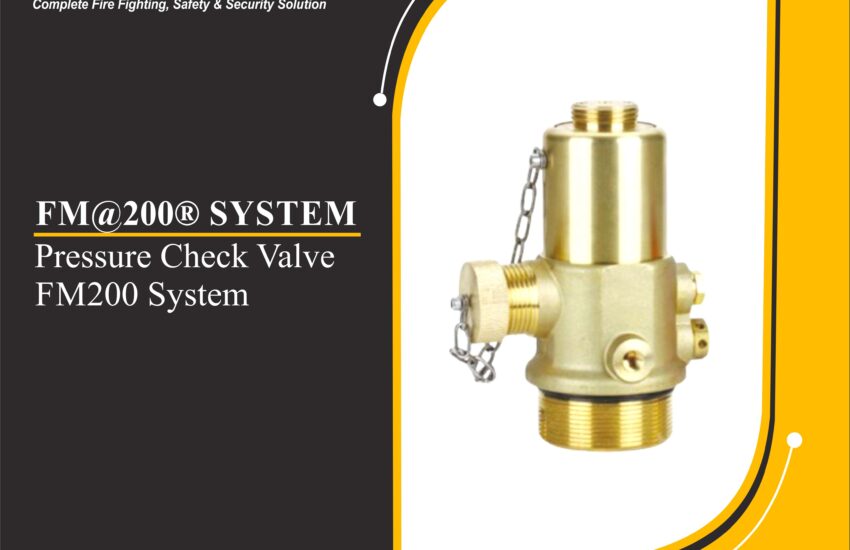Pressure Check Valve FM200 System in an FM200 fire suppression system is a one-way valve designed to allow the flow of FM200 clean agent gas (HFC-227ea) in one direction only — from the FM200 cylinder to the discharge manifold or piping system. It prevents reverse gas flow, ensuring safety, operational reliability, and compliance with international fire protection standards.
This valve is especially critical in multi-cylinder fire suppression systems, where backflow could cause gas leakage, cylinder pressure imbalance, or system failure during maintenance or discharge.
Key Features of FM200 Pressure Check Valve
One-Way Flow Protection
- Prevents reverse flow of FM200 gas from the manifold to the cylinders
- Ensures system integrity during both operation and maintenance
High-Pressure Tolerance
- Designed for high-pressure environments, typically up to 42 bar (600 psi)
- Compatible with pressurized FM200 cylinders of various sizes (e.g., 40L, 70L, 140L)
Durable Material Construction
- Made from brass, stainless steel, or corrosion-resistant alloys
- Long service life under demanding conditions
Welded or Threaded Connections
- Available in welded or threaded types to match system piping configurations
Compliance with Standards
- Conforms to TCVN 7161-1:2009, NFPA 2001, ISO 14520, and UL/FM fire suppression standards
Applications of Pressure Check Valves in FM200 Systems
Pressure check valves are used in:
- FM200 (HFC-227ea) fire suppression systems
- Cylinder manifold systems
- Modular and centralized gas discharge networks
- Data centers, server rooms, telecom facilities
- Electrical and electronic equipment rooms
- Offshore platforms and industrial sites
They are essential in multi-cylinder systems, where each cylinder must be protected from backflow in case of individual cylinder removal, service, or accidental discharge.
How the Pressure Check Valve Works in FM200 Systems
- During Normal Operation:
- The pressure from the FM200 cylinder pushes the valve open, allowing the gas to flow toward the discharge pipe or manifold.
- If Reverse Pressure Occurs:
- The valve automatically closes, blocking reverse gas flow and protecting the cylinder and system from pressure loss or damage.
- During Maintenance:
- If a cylinder is removed or isolated, the valve ensures no FM200 gas escapes from the manifold to the open cylinder port.
Installation Guidelines
- Must be installed in correct flow direction as indicated by arrow marking on the valve body.
- Should be installed vertically or horizontally depending on the system design.
- Ensure leak-proof connections using appropriate sealing and torque tools.
- Recommended to install before the manifold connection on each FM200 cylinder line.
Technical Specifications
| Specification | Details |
|---|---|
| Product Type | Pressure check valve |
| Application | FM200 gas suppression system |
| Flow Direction | One-way only |
| Pressure Rating | Up to 42 bar (600 psi) |
| Material | Stainless steel, brass, or alloy |
| Connection Type | Threaded or welded |
| Compliance | TCVN 7161-1, NFPA 2001, ISO 14520 |
| Sizes Available | DN20, DN25, DN32, DN50, DN65, DN80 |
Benefits of Using Pressure Check Valves in FM200 Systems
- Improves system safety and reliability
- Prevents loss of gas during maintenance
- Protects cylinders from pressure surges or backflow
- Reduces risk of system failure
- Required for regulatory compliance in manifold systems
Regulatory Compliance
According to TCVN 7161-1:2009 (Clause 6.2.4.4) and international standards like NFPA 2001, the use of check valves is mandatory when more than one cylinder is connected to a common manifold in a gaseous fire suppression system. These valves prevent gas leakage, enhance maintenance safety, and ensure uninterrupted protection.
Conclusion
The pressure check valve for FM200 systems is a critical safety component that ensures the safe, efficient, and compliant operation of your fire suppression system. Whether you’re operating a single-cylinder or multi-cylinder FM200 system, installing high-quality pressure check valves helps protect both your infrastructure and personnel from potential fire risks and gas-related hazards.


